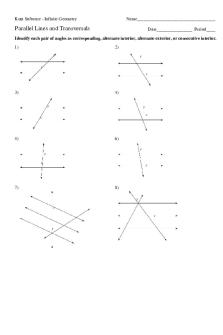9.1 - Points, Lines, Planes, and Angles PDF

| Title | 9.1 - Points, Lines, Planes, and Angles |
|---|---|
| Course | College Algebra |
| Institution | Seminole State College of Florida |
| Pages | 6 |
| File Size | 426 KB |
| File Type | |
| Total Downloads | 92 |
| Total Views | 184 |
Summary
Chapter 9.1...
Description
Chapter 9.1 – Points, Lines, Planes, and Angles
Objectives:
Understand the origins of Euclidean geometry. Identify relationships among points, lines, and planes. Classify and calculate angles.
I. The Geometry of Euclid There have been a number of civilizations throughout history that have contributed to the body of knowledge of geometry. The contributions of the Egyptians and Babylonians are notable. However, it was the ancient Greeks who insisted upon a more “rigorous” view of the subject. By “rigorous” we do not necessarily mean “difficult”, but rather, that statements in geometry be justified using formal methods of mathematical proof. (You may recall writing proofs of various mathematics assertions in your high school geometry class.) One of the most prolific contributions to the study of geometry came from Euclid (fl. 300 BCE). Widely considered the “father of geometry”, Euclid’s influential geometry text, the Elements, is the cornerstone of modern day geometry.
II. Points, Lines, and Planes The study of formal geometry begins with what we called the “undefined terms” of geometry: point
line
plane
Parallel lines are lines which lie in the same plane, but never meet, no matter how far they are extended. Parallel planes never meet, no matter how far they are extended. Line that are neither parallel nor intersecting are called skew lines.
III. Angles An angle is formed by two rays that have a common endpoint.
A degree is defined to be
1 360
of a complete rotation.
We can classify angles by their degree measure: o o o o
A right angle is an angle that measures 90°. An acute angle is an angle that measures less than 90°. An obtuse angle is an angle that measures more than 90° (but less than 180°). A straight angle is an angle that measures 180°.
When two lines intersect to form right angle, they are called perpendicular lines.
When two lines intersect, a pair of angles that lie opposite one another are called vertical angles.
Example 1 a)
Find the measure of each marked angle in the given figure. b)
If the sum of the measures of two acute angles is 90°, the angles are called complementary angles. If the sum of the measure of two acute angles is 180°, the angles are called supplementary angles.
Example 2
Find the measures of the angles in the figure, given that ∠ABC is a right angle.
Example 3 The supplement of an angle measures 10° more than three times its complement. Find the measure of the angle.
In the figure to the left, we are shown two lines 𝑚 and 𝑛. The line 𝑞 that “cuts through” these two lines is called a transversal. Assuming there are only two other lines, a transversal will always end up creating eight angles.
NOTE: A line need not cut through a pair of parallel lines to be called a transversal; a line cutting through a pair of non-parallel lines would also be called a transversal.
Both of the following statements are true regarding corresponding angles: If two parallel lines are cut by a transversal, then corresponding angles are congruent. If two corresponding angles are congruent, then two lines cut by the transversal are parallel. Since the two statements represent a conditional statement (𝑝 → 𝑞) and its converse (𝑞 → 𝑝), we can write these statements more succinctly as a biconditional statement: Corresponding Angles Theorem: Corresponding angles are congruent if and only if the two lines cut by the transversal are parallel.
Alternate Interior Angles Theorem: Alternate interior angles are congruent if and only if the two lines cut by the transversal are parallel.
Alternate Exterior Angles Theorem: Alternate interior angles are congruent if and only if the two lines cut by the transversal are parallel.
Same-Side Interior Angles Theorem: Same-side interior angles are supplementary (add up to 180°) if and only if the two lines cut by the transversal are parallel.
CAUTION: Given two parallel lines cut by a transversal, only the Corresponding Angles, Alternate Interior Angles, and Alternate Exterior Angles are congruent. Same-Side Interior Angles are NOT congruent…they are supplementary!
Example 4 a)
b)
Let lines 𝑚 and 𝑛 be parallel. Find the measure of each marked angle....
Similar Free PDFs

TANGENT PLANES AND NORMAL LINES
- 5 Pages

Waiting Lines and Simulation
- 2 Pages

Offsets and tie lines
- 31 Pages

Shatterbelts and Choke Points
- 2 Pages

91-121
- 31 Pages

Calendari angles
- 1 Pages

D Parallel and Perpendicular Lines
- 10 Pages
Popular Institutions
- Tinajero National High School - Annex
- Politeknik Caltex Riau
- Yokohama City University
- SGT University
- University of Al-Qadisiyah
- Divine Word College of Vigan
- Techniek College Rotterdam
- Universidade de Santiago
- Universiti Teknologi MARA Cawangan Johor Kampus Pasir Gudang
- Poltekkes Kemenkes Yogyakarta
- Baguio City National High School
- Colegio san marcos
- preparatoria uno
- Centro de Bachillerato Tecnológico Industrial y de Servicios No. 107
- Dalian Maritime University
- Quang Trung Secondary School
- Colegio Tecnológico en Informática
- Corporación Regional de Educación Superior
- Grupo CEDVA
- Dar Al Uloom University
- Centro de Estudios Preuniversitarios de la Universidad Nacional de Ingeniería
- 上智大学
- Aakash International School, Nuna Majara
- San Felipe Neri Catholic School
- Kang Chiao International School - New Taipei City
- Misamis Occidental National High School
- Institución Educativa Escuela Normal Juan Ladrilleros
- Kolehiyo ng Pantukan
- Batanes State College
- Instituto Continental
- Sekolah Menengah Kejuruan Kesehatan Kaltara (Tarakan)
- Colegio de La Inmaculada Concepcion - Cebu








